October 8, 2003
DIVIDE CONQUEROR
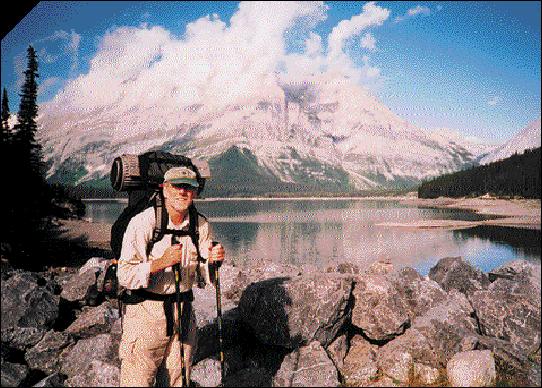
Photos courtesy of Dick Mallery
Dick Mallery of Williamsburg hiked 600 miles in July through the rugged wilderness of the Canadian Continental Divide trail, walking and camping from Waterton to Jaspar, Alberta.
Dick Mallery hikes the Canadian Continental Divide
Carol South
Special to the Herald
Walking through intense pain and endless rain, Dick Mallery completed a 600-mile hike of the Canadian Continental Divide this summer. Fueled by strawberry milkshakes (off the trail), dehydrated beans (on the trail) and eternal optimism, blisters, bears and isolation did not daunt his progress.
To Mallery, Trail Magic is always present.
“My passion is long-distance hiking,” said Mallery, a gregarious person whose trademark goodbye is ‘Keep smiling!’ “If I win the lottery, I hope to do another 1,000 miles.”
“I always hike by myself, nobody’s crazy enough to go with me,” he added.
The Williamsburg resident and owner of Dick E. Bird’s Nature News, Mallery discussed his recent trip at a talk at the Unity Church Friday evening. More than 40 people turned out to hear about his experiences and view pictures from the trip. He also brought
along his backpack, hiking poles, cooking stove and other equipment to share with the audience.
“The further north I got, the wilder it was and the harder the water crosses,” said Mallery, who lost 30 pounds on his trip. “This trip, I had a time table, only 30 days, so I had to walk fast.”
Mallery has been trekking and backpacking for 30 years and in 1999 he began his Continental Divide quest. That year, he hiked more than 3,200 miles from New Mexico to the Canadian Border, following the Continental Divide Trail for five months.
Starting on July 3 this year, he set out from Waterton, Alberta, reaching Jaspar, Alberta 30 days later. His next goal is a 1,000-mile trek from Jaspar to the Yukon, through even more remote and wild areas. Some day he hopes to follow the North American continent’s backbone through the Yukon and Alaska to the Arctic Ocean.
Walking from dawn to past dusk over 16-hour-long days was taxing, especially on Mallery’s feet. He noted that he often blisters on long treks but usually the feet toughen up by about 30 days. For this shorter trip, his feet stayed tender the whole time. His brisk pace covered more than 25 miles per day over mountains and through streams and valleys — sometimes through places where there was no trail — contributing to painful blisters on the balls of his feet.
“I swore to myself that this trip I wasn’t going to let my feet get blistered,” said Mallery, who doctored his feet with everything from duct tape to triple anti-biotic cream. “After you walk a while, they just kind of numb up and you walk through the pain.”
Mallery’s wife Gaila, and daughter, Maggie, supported him on his expedition, as they have on his previous treks. Gaila drives their motorhome to campgrounds paralleling his route; for this quest, her parents joined them on the trip.
Gaila and Maggie track Mallery’s progress, making sure to feed and clean him up on his weekly exits from the trail. They also explore the areas they visit and enjoy meeting a changing array of characters.
“Maggie and I did a lot of day hiking and I kept the business going from the motorhome,” said Gaila Mallery.
Mallery had a satellite communicator to help them keep track of him but a mishap early on drained the battery. He had stopped to link to the satellite and had just turned on the communicator when a gust of wind blew his pack away. It rolled down a steep mountainside
with him in pursuit and he spent hours retrieving it. Meanwhile, the juice drained from the communicator’s batteries.
Always adaptable, the Mallerys went to Plan B: He emailed his dad in Acme the location, who would put it on the Mallery’s answering machine, which Gaila would access remotely for news.
Bear spray was a new addition to his pack for this expedition, though two encounters with grizzlies never merited its use.
Through all the challenges, Mallery noted that the scenery was pristine and beautiful. Despite three weeks of rain during his month of walking, he was inspired by nature throughout his trip.
“Everything was like a calendar photo,” he said.
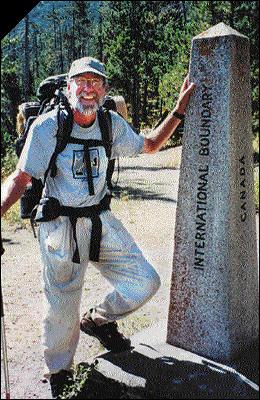
In 1999, Mallery completed a 3,200-mile hike of the Continental Divide from New Mexico to the Canadian Border. Pictured here at the end of that hike, at the international border crossing between the United States and Canada, he returned to the same spot this July to begin hiking the Canadian Continental Divide trail.
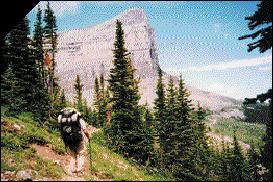
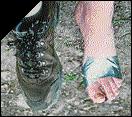
Duct tape sounded like a good idea to help cushion and protect painful blisters during his long hike, but Mallery discovered a huge downside: removal took most of the skin with it.
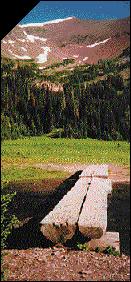
Crossing water rarely meant using a bridge — and keeping the feet dry — as the rugged trail of the Canadian Continental Divide left hikers to their own devices.




